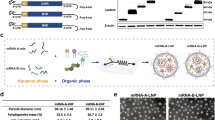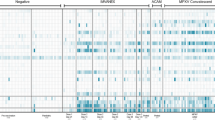Abstract
The potential use of smallpox as a biological weapon has led to the production and stockpiling of smallpox vaccine and the immunization of some healthcare workers. Another public health goal is the licensing of a safer vaccine that could benefit the millions of people advised not to take the current one because they or their contacts have increased susceptibility to severe vaccine side effects1. As vaccines can no longer be tested for their ability to prevent smallpox, licensing will necessarily include comparative immunogenicity and protection studies in non-human primates. Here we compare the highly attenuated modified vaccinia virus Ankara (MVA)2 with the licensed Dryvax vaccine in a monkey model. After two doses of MVA or one dose of MVA followed by Dryvax, antibody binding and neutralizing titres and T-cell responses were equivalent or higher than those induced by Dryvax alone. After challenge with monkeypox virus, unimmunized animals developed more than 500 pustular skin lesions and became gravely ill or died, whereas vaccinated animals were healthy and asymptomatic, except for a small number of transient skin lesions in animals immunized only with MVA.
This is a preview of subscription content, access via your institution
Access options
Subscribe to this journal
Receive 51 print issues and online access
$199.00 per year
only $3.90 per issue
Buy this article
- Purchase on Springer Link
- Instant access to full article PDF
Prices may be subject to local taxes which are calculated during checkout




Similar content being viewed by others
References
Fulginiti, V. A., Papier, A., Lane, J. M., Neff, J. M. & Henderson, D. A. Smallpox vaccination: a review, part II. Adverse events. Clin. Infect. Dis. 37, 251–271 (2003)
Mayr, A., Hochstein-Mintzel, V. & Stickl, H. Abstammung, eigenschaften und verwendung des attenuierten vaccinia-stammes MVA [Passage history, properties, and applicability of the attenuated vaccinia virus strain MVA]. Infection 3, 6–14 (1975)
Meyer, H., Sutter, G. & Mayr, A. Mapping of deletions in the genome of the highly attenuated vaccinia virus MVA and their influence on virulence. J. Gen. Virol. 72, 1031–1038 (1991)
Antoine, G., Scheiflinger, F., Dorner, F. & Falkner, F. G. The complete genomic sequence of the modified vaccinia Ankara strain: comparison with other orthopoxviruses. Virology 244, 365–396 (1998)
Carroll, M. & Moss, B. Host range and cytopathogenicity of the highly attenuated MVA strain of vaccinia virus: propagation and generation of recombinant viruses in a nonhuman mammalian cell line. Virology 238, 198–211 (1997)
Drexler, I., Heller, K., Wahren, B., Erfle, V. & Sutter, G. Highly attenuated modified vaccinia virus Ankara replicates in baby hamster kidney cells, a potential host for virus propagation, but not in various human transformed and primary cells. J. Gen. Virol. 79, 347–352 (1998)
Blanchard, T. J., Alcami, A., Andrea, P. & Smith, G. L. Modified vaccinia virus Ankara undergoes limited replication in human cells and lacks several immunomodulatory proteins: implications for use as a human vaccine. J. Gen. Virol. 79, 1159–1167 (1998)
Sutter, G. & Moss, B. Nonreplicating vaccinia vector efficiently expresses recombinant genes. Proc. Natl Acad. Sci. USA 89, 10847–10851 (1992)
Stittelaar, K. J. et al. Safety of modified vaccinia virus Ankara (MVA) in immune-suppressed macaques. Vaccine 19, 3700–3709 (2001)
Hochstein-Mintzel, V., Huber, H.-C. & Stickl, H. Die orale und nasale immuniserung mit poxvirus vacciniae III. Mitteilung: tierexperimentelle untersuchungen [Oral and nasal immunization with poxvirus vaccine. Part III: experimental animal investigations]. Zentralbl. Bakteriol. Hyg. 156, 30–96 (1972)
Hochstein-Mintzel, V., Hänichen, T., Huber, H. C. & Stickl, H. Vaccinia- und variolaprotektive wirkung des modifezierten vaccinia-stammes MVA bei intramuskulärer immunisierung [An attenuated strain of vaccinia virus (MVA). Successful intramuscular immunization against vaccinia and variola]. Zentralbl. Bakteriol. Hyg. 230, 283–297 (1975)
Belyakov, I. M. et al. Shared modes of protection against poxvirus infection by attenuated and conventional smallpox vaccine viruses. Proc. Natl Acad. Sci. USA 100, 9458–9463 (2003)
Stickl, H. et al. MVA-stufenimpfung gegen pocken. klinische erprobung des attenuierten pocken-lebendimpfstoffes, stamm MVA [MVA vaccination against smallpox: clinical trials of an attenuated live vaccinia virus strain (MVA)]. Dtsch. Med. Wochenschr. 99, 2386–2392 (1974)
Mayr, A., Stickl, H., Müller, H. K., Danner, K. & Singer, H. Der pockenimpfstamm MVA: marker, genetische struktur, erfahrungen mit der parenteralen schutzimpfung und verhalten im abwehrgeschwächten organismus [The smallpox vaccination strain MVA: marker, genetic structure, experience gained with parenteral vaccination and behavior in organisms with debilitated defense mechanism]. Zentralbl. Bakteriol. Hyg. 167, 375–390 (1978)
Mayr, A. History of variola, smallpox-eradication and MVA. Berl. Munch. Tierarztl. Wochenschr. 112, 322–328 (1999)
Zaucha, G. M., Jahrling, P. B., Geisbert, T. W., Swearengen, J. R. & Hensley, L. The pathology of experimental aerosolized monkeypox virus infection in cynomolgus monkeys (Macaca fascicularis). Lab. Invest. 81, 1581–1600 (2001)
LeDuc, J. W., Damon, I., Relman, D. A., Huggins, J. & Jahrling, P. B. Smallpox research activities: U.S. interagency collaboration, 2001. Emerg. Infect. Dis. 8, 743–745 (2002)
Arita, I., Jezek, Z., Khodakevich, L. & Ruti, K. Human monkeypox: a newly emerged orthopoxvirus zoonosis in the tropical rain forests of Africa. Am. J. Trop. Med. Hyg. 34, 781–789 (1985)
Breman, J. G. & Henderson, D. A. Poxvirus dilemmas—monkeypox, smallpox, and biologic terrorism. N. Engl. J. Med. 339, 556–559 (1998)
Smith, G. L., Vanderplasschen, A. & Law, M. The formation and function of extracellular enveloped vaccinia virus. J. Gen. Virol. 83, 2915–2931 (2002)
Law, M. & Smith, G. L. Antibody neutralization of the extracellular enveloped form of vaccinia virus. Virology 280, 132–142 (2001)
Hooper, J. W., Custer, D. M., Schmaljohn, C. S. & Schmaljohn, A. L. DNA vaccination with vaccinia virus L1R and A33R genes protects mice against a lethal poxvirus challenge. Virology 266, 329–339 (2000)
Hooper, J. W., Custer, D. M. & Thompson, E. Four-gene-combination DNA vaccine protects mice against a lethal vaccinia virus challenge and elicits appropriate antibody responses in nonhuman primates. Virology 306, 181–195 (2003)
Galmiche, M. C., Goenaga, J., Wittek, R. & Rindisbacher, L. Neutralizing and protective antibodies directed against vaccinia virus envelope antigens. Virology 254, 71–80 (1999)
Wolffe, E. J., Vijaya, S. & Moss, B. A myristylated membrane protein encoded by the vaccinia virus L1R open reading frame is the target of potent neutralizing monoclonal antibodies. Virology 211, 53–63 (1995)
Earl, P. L., Americo, J. L. & Moss, B. Development and use of a vaccinia virus neutralization assay based on flow cytometric detection of green fluorescent protein. J. Virol. 77, 10684–10688 (2003)
Appleyard, G., Hapel, A. J. & Boulter, E. A. An antigenic difference between intracellular and extracellular rabbitpox virus. J. Gen. Virol. 13, 9–17 (1971)
Law, M., Hollinshead, R. & Smith, G. L. Antibody-sensitive and antibody-resistant cell-to-cell spread by vaccinia virus: role of the A33R protein in antibody-resistant spread. J. Gen. Virol. 83, 209–222 (2002)
Breman, J. G. & Henderson, D. A. Diagnosis and management of smallpox. N. Engl. J. Med. 346, 1300–1308 (2002)
Speller, S. A. & Warren, A. P. Ex vivo detection and enumeration of human antigen-specific CD8+ T lymphocytes using antigen delivery by a recombinant vaccinia expression vector and intracellular cytokine staining. J. Immunol. Methods 262, 167–180 (2002)
Acknowledgements
We are grateful to R. Elkins (NIAID) for animal acquisition and to R. Byrum (Bioqual, Inc.) for animal care and immunizations. The work was supported by the National Institute of Allergy and Infectious Diseases.
Author information
Authors and Affiliations
Corresponding author
Ethics declarations
Competing interests
The authors declare that they have no competing financial interests.
Supplementary information
Supplementary Figure 1
Photographs of Dryvax-induced skin lesions. (PDF 551 kb)
Supplementary Figure 2
Antibody responses of individual animals. (PDF 78 kb)
Supplementary Figure 3
Reduction of cell-to-cell spread of vaccinia virus by sera fromindividual animals. (PDF 195 kb)
Supplementary Figure 4
Monkeypox viral skin lesions. (PDF 47 kb)
Rights and permissions
About this article
Cite this article
Earl, P., Americo, J., Wyatt, L. et al. Immunogenicity of a highly attenuated MVA smallpox vaccine and protection against monkeypox. Nature 428, 182–185 (2004). https://doi.org/10.1038/nature02331
Received:
Accepted:
Issue Date:
DOI: https://doi.org/10.1038/nature02331
This article is cited by
-
Cross-reactive immune responses to monkeypox virus induced by MVA vaccination in mice
Virology Journal (2023)
-
Real-world effectiveness of a single dose of mpox vaccine in males
Nature Medicine (2023)
-
Monkeypox virus: past and present
World Journal of Pediatrics (2023)
-
Low levels of monkeypox virus-neutralizing antibodies after MVA-BN vaccination in healthy individuals
Nature Medicine (2023)
-
Monkeypox virus-infected individuals mount comparable humoral immune responses as Smallpox-vaccinated individuals
Nature Communications (2023)
Comments
By submitting a comment you agree to abide by our Terms and Community Guidelines. If you find something abusive or that does not comply with our terms or guidelines please flag it as inappropriate.



